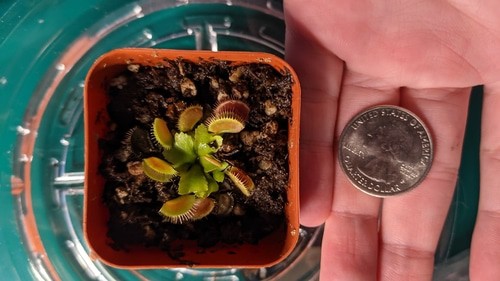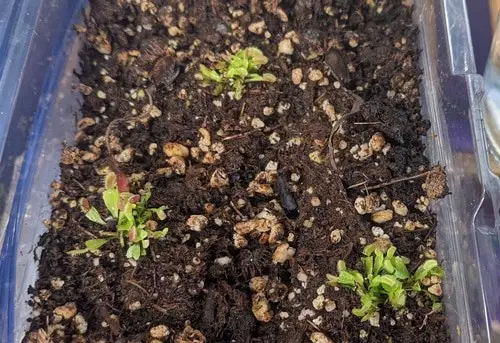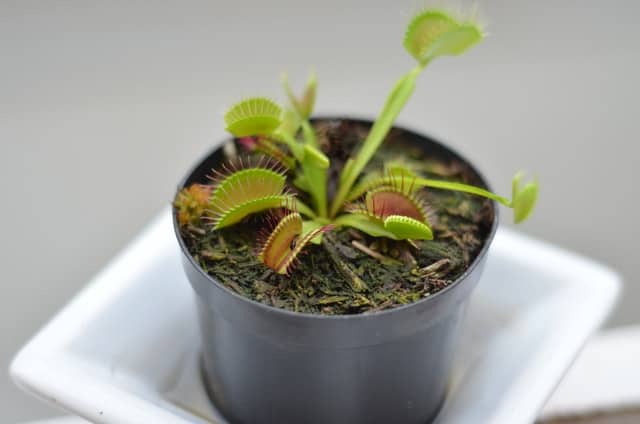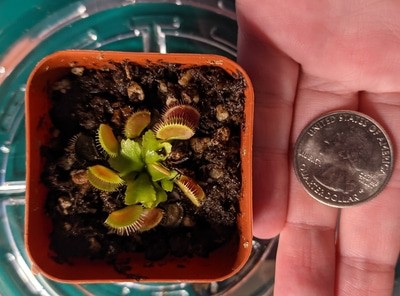Growing seedlings or baby Venus flytraps can be a big challenge. I have learned the hard way and killed plants along the way by making silly mistakes. For that reason, I’m writing this post today to prevent you from making any of those mistakes, so you can keep your baby Venus flytraps alive and healthy.
Venus flytrap seedlings need exposure to plenty of sun and water to live. They need at least 6 to 8 hours of sunlight. Also, they must be planted in carnivorous plant soil, which must be humid, but not damped at all times. Other considerations are humidity, dormancy, feeding, and containers.
In this article, I will cover six major care considerations to account for when growing seedlings or baby Venus flytraps: watering, lighting, soil, feeding, dormancy, and potting containers.
I have been growing 4 Venus flytrap seedlings over the past six months. The larger one is about six months old since I divided it. I got it through rhizome divisions. And, the other three spurred a few months ago through leaf pulling propagation.


Venus Flytrap Seedling Care
Venus Flytrap Watering Instructions
Venus flytraps need a consistent water supply of pure water.
Never water your Venus flytrap with tap water or bottled water. Instead, employ distilled water, reverse osmosis water, or rainwater. The water source cannot contain additives, such as minerals. Minerals or nutrients in the water can build-up in the soil and kill Venus flytraps.
Older Venus flytraps might be able to survive if you use the wrong water source once or twice, but young seedlings can be very affected by the minerals in tap water or bottled water. Always use pure water sources to keep your plants alive.
In terms of frequency, you must water your Venus flytrap often (here is a guide on watering that can help you use the optimal amount) (here is a guide on watering that can help you use the optimal amount). I use the water tray method, as you can see in the picture below.

I place the pot of my plants on top of a tray of water, and I let it sit there until it dries out, and then I refill it.
The main goal is straightforward: you want to keep the soil always humid, always moist, but never flooded. If it’s flooded, we can have root rot issues, and for that reason, you want to always keep it at high humidity but not at extreme moisture. Also, consider misting your Venus flytraps by using a manual mister or even employ a humidifier.
Lighting Requirements
In terms of lighting, young seedlings benefit from strong lighting, and you can see a huge difference between seedlings that have been exposed to long hours of sunlight versus very short periods of sunlight.
For best results, I recommend growing Venus flytraps outdoors where they can have six or more direct sunlight hours.
If you grow seedlings indoors, you can still do so, but it is challenging. You need to find a very sunny spot or use artificial lighting.
For my seedlings, I have been using a led plant light. If you need to buy artificial light for your plants, here is a link to the plant light I use. Because artificial lighting is not as efficient and as powerful as sunlight, I always use a timer of 12 hours. Then, my plants are exposed to 12 hours of artificial light to make sure that they remain healthy.
Carnivorous Plant Soil
For your soil choice, you must always use carnivorous plant soil. If you are unfamiliar with carnivorous plant soil, you can follow this link to learn more:
Carnivorous Plant Soil Guide: https://bit.ly/30y9ecA
Carnivorous plants need to grow in potting media that lacks nutrients and minerals, as those substances are harmful to them. For Venus flytraps, most people employ a mixture between moss and sand or perlite. The moss can be long-fibered sphagnum moss or peat moss. All the elements in the additive have to be pure (no fertilizers).
I make my own soil mix for my Venus flytrap seedlings. It is about 20 % perlite and the rest peat moss.
Those elements are completely pure. They can’t have any minerals or fertilizers, which can be harmful to Venus flytraps. This is of crucial importance, as young Venus flytraps are resilient, but they can also be quite delicate to exposure to minerals. Always make sure to use the correct soil type.
Venus Flytrap Seedling Feeding
Now let’s cover the next element, feeding.
The traps of baby Venus flytraps work. Even though they are very young and tiny, they are ready to capture bugs.
The best recommendation for feeding young Venus flytraps is to grow them outdoors. In the outdoors, they can capture their own bugs. They might be able to consume a tiny gnat, a really small fly, or mosquito.
It is also possible to manually feed your Venus flytraps, but because they are so tiny, it tends to be very difficult. I will anyway share this link to a video that shows you how to feed baby Venus flytraps. Then, you can make your own decision if you want to go through the process. But I think it’s a little bit complicated, especially when your plant is at such an early stage. If you want to encourage your plant’s growth, the best thing you can do is to provide more lighting. High light exposure has the same effects as feeding.
Venus Flytrap Dormancy
During the winter months, Venus flytraps go into a hibernation state known as dormancy. Venus flytraps should undergo dormancy every year. Skipping dormancy many years in a row kills Venus flytraps. Still, it is possible to skip dormancy in some cases, especially for seedlings.
When growing seedlings for the first time, I recommend skipping the first dormancy. Before going through the dormancy process, you must make sure your plant is healthy and well adapted to the environment.
Skipping the first dormancy won’t kill the plant. But, the following year, your plants MUST go dormant.
Potting Containers
This final care consideration is often overlooked.
Pots can leach minerals to the ground and slowly kill Venus flytraps. Since young Venus flytraps are very sensitive to minerals, avoid terracotta or clay pots. Instead, choose plastic, glass, glazed ceramic, or Styrofoam containers; those materials are safe for carnivorous plants.
Venus Flytrap Seedling Care Summary
Follow these instructions to keep your baby Venus flytraps healthy and thriving:
- Provide plenty of light for your seedlings: If you grow them outdoors, provide at least 6 hours of sunlight.
- Avoid exposing Venus flytrap seedlings to temperatures above 95 F as they can dry out.
- Do not let your seedlings dry out: Venus flytrap seedlings need high humidity to survive. They can die very quickly if the soil dries out.
- Consider using the water tray method for watering: By letting the plants sit in water, you ensure the soil is humid but not overwatered.
- Only water with distilled, reverse osmosis, or rainwater: Tap water or standard bottled water can kill Venus flytraps.
- Employ carnivorous plant soil as potting media.
- Keep your plants in a high humidity environment: Mist them often or use a humidifier.
- Avoid terracotta or clay pots.
- Choose pots with drainage to avoid root rot.
- Grow your seedlings outdoors so that they can access insects: Baby Venus flytraps can capture their food and benefit from the added nutrition.
- Please do not feed your Venus flytrap manually until you have done enough research: Some people make big mistakes when feeding their Venus flytraps. Avoid harming your plant by learning about the feeding process (here is some information.)
- Let your seedlings go dormant during the winter only if you are familiar with the process.
- Get your seedlings adjusted to the environment before their first dormancy.
- Do not fertilize your plants: The nutrients in fertilizers are harmful to Venus flytraps; they can kill seedlings quickly.
How to Get Venus Flytrap Seedlings
If you would like to learn how to propagate Venus flytraps, I have two articles that will be perfect for you. You can learn about leaf pulling propagation, flower stalk propagation, growing Venus flytraps from seeds, and much more:
- Step-by-Step Guide to Venus Flytrap Flower Stalk Propagation
- How Do Venus Flytrap Reproduce? – 4 Propagation Methods
For more information on Venus flytrap care, make sure to download this free care sheet.


